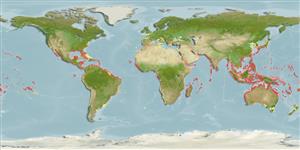Environment: milieu / climate zone / depth range / distribution range
Ecología
marino; oceanodromo (Ref. 51243); rango de profundidad 0 - 20 m. Subtropical; 44°N - 36°S, 180°W - 180°E
Widespread in tropical and subtropical zones of all oceans including the western Mediterranean Sea and part of the Caribbean Sea (Ref. 3720), probably absent in the inland seas of southeastern Asia (Sulawesi Sea, Sulu Sea, Flores, Banda, Ceram and Halmahera seas (Ref. 27313)), and the Benguela Current (Ref. 4498). Eastern Pacific: Mexico to central Chile; also the Galapagos and Hawaii. Western Pacific: Japan, Marshall Islands, Philippines, Australia (Ref. 5530), and Tahiti.
Tamaño / Peso / Age
Maturity: Lm ? range ? - ? cm
Max length : 30.0 cm TL macho / no sexado; (Ref. 9987); common length : 20.0 cm TL macho / no sexado; (Ref. 5217)
Espinas dorsales (total) : 0; Radios blandos dorsales (total) : 12 - 15; Espinas anales: 0; Radios blandos anales: 12 - 14; Vértebra: 43 - 46. Body dark, iridescent blue above, silvery white below; pectorals and caudal fin greyish, other fins not pigmented (Ref. 2797). Juveniles with or without black bars (Ref. 2797). Branchiostegal rays: 9-11 (Ref. 36606).
Adults occur in surface waters, both near and far from the coast (Ref. 5217). Form schools. Capable of leaping out of the water and gliding for long distances above the surface. Feed mostly on crustaceans and other planktonic animals. Preyed upon by swordfish, tunas and many other larger pelagic fishes (Ref. 9987). Oviparous, with planktonic eggs and larvae (Ref. 36606).
Parin, N.V., 1996. On the species composition of flying fishes (Exocoetidae) in the West-Central part of tropical Pacific. J. Ichthyol. 36(5):357-364. (Ref. 27313)
IUCN Red List Status (Ref. 130435: Version 2024-1)
Threat to humans
Harmless
Human uses
Pesquerías: comercial
Herramientas
Special reports
Download XML
Fuentes de Internet
Estimates based on models
Preferred temperature (Ref.
123201): 23.2 - 29.2, mean 27.9 °C (based on 4828 cells).
Phylogenetic diversity index (Ref.
82804): PD
50 = 0.5312 [Uniqueness, from 0.5 = low to 2.0 = high].
Bayesian length-weight: a=0.00631 (0.00288 - 0.01384), b=3.05 (2.85 - 3.25), in cm total length, based on LWR estimates for this (Sub)family-body shape (Ref.
93245).
Nivel trófico (Ref.
69278): 3.0 ±0.09 se; based on food items.
Resiliencia (Ref.
120179): Alto, población duplicada en un tiempo mínimo inferior a 15 meses (Preliminary K or Fecundity.).
Fishing Vulnerability (Ref.
59153): Low vulnerability (20 of 100).
